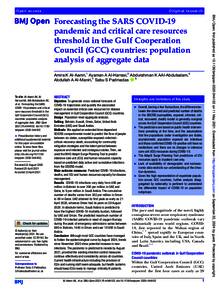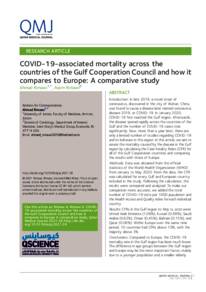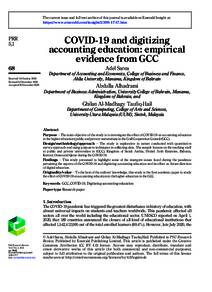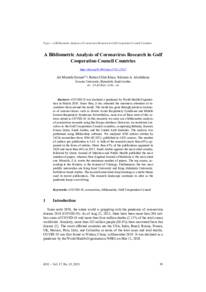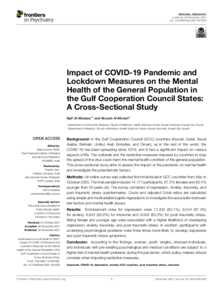Document
Forecasting the SARS COVID-19 pandemic and critical care resources threshold in the Gulf Cooperation Council (GCC) countries : population analysis of aggregate data.
Identifier
DOI: 10.1136/bmjopen-2020-044102
Source
BMJ Open. v. 11, 5, e044102
Contributors
Al-Harrasi, Ayaman A., Author
AAl-Abdulsalam, Abdurahman K., Author
Al-Maniri, Abdullah A., Author
Padmadas, Sabu S., Author
Country
United Kingdom.
Publisher
BMJ Publishing Group.
Gregorian
2021-05-11
Language
English
English abstract
Objective To generate cross-national forecasts of COVID-19 trajectories and quantify the associated impact on essential critical care resources for disease management in Gulf Cooperation Council (GCC) countries. Design Population-level aggregate analysis. Setting Bahrain, Kuwait, Oman, Qatar, United Arab Emirates (UAE) and Saudi Arabia. Methods We applied an extended time-dependent SEICRD compartmental model to predict the flow of people between six states, susceptible-exposed-infected-critical-recovery-death, accounting for community mitigation strategies and the latent period between exposure and infected and contagious states. Then, we used the WHO Adaptt Surge Planning Tool to predict intensive care unit (ICU) and human resources capacity based on predicted daily active and cumulative infections from the SEICRD model. Main outcome measures Predicted COVID-19 infections, deaths, and ICU and human resources capacity for disease management. Results COVID-19 infections vary daily from 498 per million in Bahrain to over 300 per million in UAE and Qatar, to 9 per million in Saudi Arabia. The cumulative number of deaths varies from 302 per million in Oman to 89 in Qatar. UAE attained its first peak as early as 21 April 2020, whereas Oman had its peak on 29 August 2020. In absolute terms, Saudi Arabia is predicted to have the highest COVID-19 mortality burden, followed by UAE and Oman. The predicted maximum number of COVID-19-infected patients in need of oxygen therapy during the peak of emergency admissions varies between 690 in Bahrain, 1440 in Oman and over 10 000 in Saudi Arabia. Conclusion Although most GCC countries have managed to flatten the epidemiological curve by August 2020, trends since November 2020 show potential increase in new infections. The pandemic is predicted to recede by August 2021, provided the existing infection control measures continue effectively and consistently across all countries. Current health infrastructure including the provision of ICUs and nursing staff seem adequate, but health systems should keep ICUs ready to manage critically ill patients.
ISSN
2044-6055
Resource URL
Category
Journal articles

